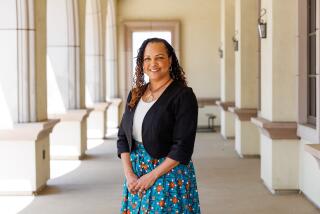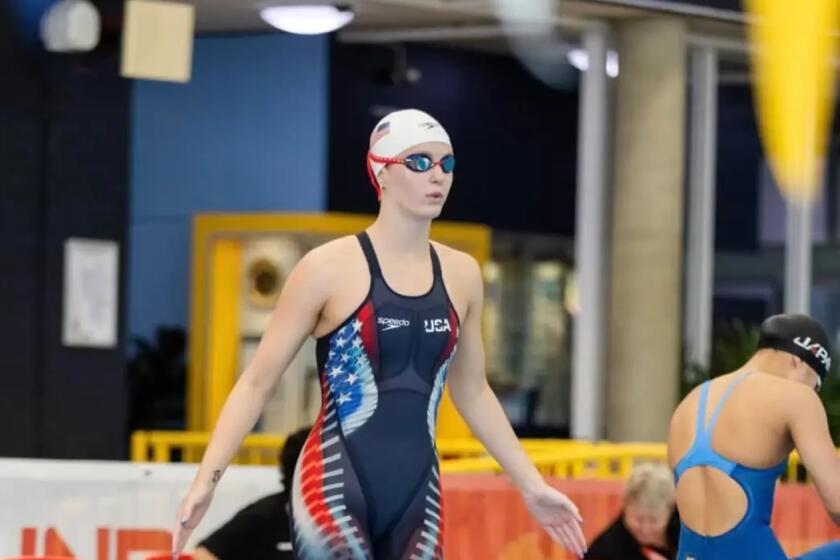RISING ABOVE IT ALL : High Jumper Flies Despite Sight Defect
- Share via
SAN DIEGO — Sometimes when she’s preparing to high jump, San Diego State’s Marla Runyan will pace off her steps, turn around, get down on her knees and look up at the high jump bar against the sky.
Sometimes, she will walk up to the bar, look at it and then keep her eye on the bar as she walks backward, pacing off her steps.
Baseball players are told to keep their eyes on the ball when they are hitting. In order for Runyan to hit her jumps, she works especially hard at keeping her eyes on the bar.
She has to, because she’s legally blind.
“Every high jumper has a measured step to the bar,” she explained. “So I take my steps, and (do those things) to help me see the bar.”
Her biggest problem occurs when the bar and background are the same color and she can’t distinguish between the two.
“In high school, at the Marmonte League championships at Simi Valley (High School), they had a yellow bar, and there were yellow mountains behind it, and the sun was coming down and glaring,” she said. “That was difficult.”
Still, she overcame the obstacles to leap 5-feet 7-inches, the Camarillo High School record. As long as she’s not surprised by the height of the bar in mid-approach, she said, she’s OK.
“As long as I don’t say, ‘Oh my God, there’s the bar, look how high it is,’ ” she said.
One day nine years ago, she walked into her fourth-grade classroom and noticed that she couldn’t see the blackboard. She wondered why.
So she and her mother went to see an optometrist, who tested her for lenses. When she said she still couldn’t see, the optometrist told her it was in her head. So did the next two or three optometrists she visited.
Finally, she went to an ophthalmologist who recommended that she be examined by a retina specialist.
“That’s when I finally found out it was in my eyes,” said Runyan, 19, a freshman.
She was diagnosed as having Stargardt’s disease, which is a macular degeneration of the retina. The macula is the part of the retina that helps you see fine detail--words on a sign, colors, details on a face.
“Part of the macula died in both of my eyes,” she said. “The cause is still unknown as far as I know.”
Her vision today is 20/200 in both eyes with contact lenses, 20/400 without. Through a bioptic lens, she is able to read and do her homework (she has a 3.82 grade point average). She was even able to get her driver’s license when she turned 17.
But when she steps onto the track, her handicap is negated by her athletic ability.
On Feb. 13, in her first college track meet, Runyan cleared 5-7 in the high jump. Two months later, on April 16, she went 5-9 at UC Irvine in a meet with Irvine and Fresno State.
But the 5-9, which would have been a personal best, didn’t count. She and teammate Veronica Wuerful both went 5-8 to tie for first place, then went 5-9 in the tiebreaker. The Pacific Coast Athletic Conference disqualified the jumps because conference rules don’t allow for a tiebreaker when two teammates tie for first.
Still, 5-8 is the highest by an SDSU high jumper this year.
“I don’t want to be some kind of hero,” she said. “I run track because I love it. I saw a one-legged skier interviewed once, and he said he didn’t want to be labeled as courageous. He’s just a one-legged skier who loves to ski.”
“She’s remarkable,” Wuerful said. “She’s doing as well as I am, or I’m doing as well as she is, and she’s got such a handicap.”
In high school, Runyan also ran the 400 meters and anchored the mile relay. And for two years, she ran a leg in the 400 relay.
“I don’t do any running anymore,” she said. “Just high jumping. I thought a lot about doing both. And I started training some to run the mile relay. I kind of miss that. But I don’t want to run it unless I can do a good job.”
A few weeks ago, however, SDSU Coach Jim Cerveny was in the press box when he looked down on the field and saw Runyan getting ready to run a leg in the non-varsity 1,600 relay.
“I didn’t know they were going to do it,” he said. “It was a team of throwers and jumpers. I was glad to see her volunteer.
“She’s a very, very hard worker. She doesn’t let anything get in her way once she sets her mind to something. A lot of people wouldn’t know she has a sight problem, because she’s normal. She’s not the kind of person who will tell you, either.”
Runyan first toured the campus last May, and one of the biggest reasons she decided to attend SDSU was that the school has a good program for disabled students.
“They had a lot of programs for the blind,” she said. “I liked what I saw.”
She’s still happy with the choice.
“I’m really glad I came here,” she said. “I love the people on the track team, and school is going really well. Classes have gone really, really well.
“You have to adjust to a lot of things, such as being more independent. And my vision problems make it more difficult. The frustrating thing is that people don’t know I have a visual disability. I don’t mind questions, but it’s really hard when people assume things about you. It makes it harder to meet people.”
Still, while acknowledging the problems, she isn’t looking for sympathy.
“When I go to Disabled Student Services,” she said, “I see people who have it harder than me, and I think, ‘What am I complaining about? I really have it made.’ ”
More to Read
Get our high school sports newsletter
Prep Rally is devoted to the SoCal high school sports experience, bringing you scores, stories and a behind-the-scenes look at what makes prep sports so popular.
You may occasionally receive promotional content from the Los Angeles Times.






